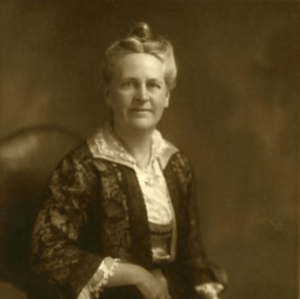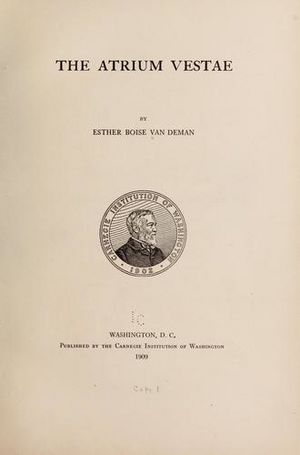Esther Boise Van Deman facts for kids
Quick facts for kids
Esther Boise Van Deman
|
|
|---|---|
 |
|
| Born | October 1, 1862 |
| Died | May 3, 1937 (aged 74) |
| Nationality | United States |
| Citizenship | American |
| Alma mater | University of Michigan |
| Known for | Roman archaeology |
| Scientific career | |
| Fields | Archaeology |
| Thesis | "The Cult of Vesta Publica and the Vestal Virgins" (1898) |
Esther Boise Van Deman (born October 1, 1862 – died May 3, 1937) was a very important archaeologist. She lived and worked in the late 1800s and early 1900s. She became famous for creating special ways to figure out when ancient buildings in Rome were built.
Contents
Early Life and Education
Esther Boise Van Deman was born in South Salem, Ohio. Her father was Joseph Van Deman, and her mother was Martha Millspaugh. Esther was the youngest of six children in her family.
She started studying at the University of Michigan in 1886 when she was 24 years old. She earned her first degree in Latin in 1891. While there, she worked closely with Professor Francis Kelsey. He encouraged her to study the Vestal Virgins, who were ancient Roman priestesses.
Esther continued her studies at the University of Michigan. She was one of the first women to do advanced studies there. She received her Master's degree in 1891. After that, she became the first fellow in Latin at Bryn Mawr College in Pennsylvania.
Teaching and Research
Esther later moved to Baltimore and taught Latin at Wellesley College. Then she taught at Bryn Mawr School. In 1895, she gave a presentation about the duties of the Vestal Virgins.
In 1896, she began working on her advanced degree at the University of Chicago. In 1898, she became the first woman to earn a PhD in Latin from that university. Her main research was still about the Vestal Virgins. After getting her PhD, she taught Latin at Mount Holyoke College until 1901.
Discoveries in Rome
In 1901, Van Deman traveled to Rome, Italy, with help from her mentor, Professor Kelsey. She wanted to find more information about the Vestal Virgins. At that time, the House of the Vestals was being dug up by archaeologists. Van Deman often watched the dig and studied the things they found.
She returned to America in 1903 to teach Latin and classical archaeology at Goucher College. But she went back to Rome in 1905. In 1906, she received a special award called a Carnegie Institution fellowship. This allowed her to study with the School of Classical Studies for three years. She was only the third woman to receive this important fellowship.
From 1910 to 1925, she worked for the Carnegie Institution in Washington, D.C.. Then, from 1925 to 1930, she taught Roman archaeology at the University of Michigan.
How She Dated Ancient Buildings
Esther Boise Van Deman spent her life studying how to figure out when ancient buildings were built. She looked closely at the materials used to construct them.
In 1907, while in Rome, she noticed something important. She saw that the bricks used to block a doorway in the Atrium Vestae were different from the bricks of the main building. This difference in building materials gave her a clue. She realized that these differences could help tell the age of ancient structures.
The Carnegie Institution published her first findings in a book called The Atrium Vestae in 1909. Van Deman then looked at other types of Roman concrete and brick buildings. She published her methods in an article called "Methods of Determining the Date of Roman Concrete Monuments."
Her basic way of dating buildings, with only a few changes, became the standard method for Roman archaeology. She took many photos of her work in Rome to record her archaeological findings.
Her most important book, The Building of the Roman Aqueducts, was published in 1934. She wrote it after she retired and settled in Rome. Esther Boise Van Deman passed away in Rome, Italy, on May 3, 1937. She is buried in the Protestant Cemetery in Rome.
At the time of her death, Van Deman was working on another big study about Roman construction. Her work was finished and published by another scholar, Marion Elizabeth Blake.
Esther's nephew, Ralph Van Deman Magoffin, also became interested in archaeology. He published a study about an Italian city. It's possible that his aunt inspired his interest in the field.
Works
- "The Value of Vestal Statues as Originals", American Journal of Archaeology 12.3 (July-Sept. 1908) 324-342
- The Atrium Vestae 1909
- The So-Called Flavian Rostra 1909
- "Methods of Determining the Date of Roman Concrete Monuments", American Journal of Archaeology. April–June 1912
- The Porticus of Gaius and Lucius 1913
- "The Sullan Forum", Journal of Roman Studies 1922
- The Sacra Via of Nero 1925
- The Building of the Roman Aqueducts 1934
See also
 In Spanish: Esther Boise Van Deman para niños
In Spanish: Esther Boise Van Deman para niños



